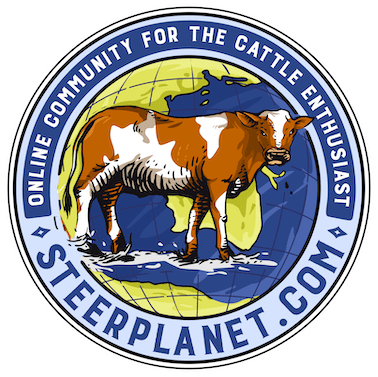I would like to express a few thoughts and observations about Terook Superex 38G and the Webollabolla cattle. We owned 38G from when we acquired him as a 2 year old until his ultimate death.
We began raising Shorthorns in earnest in 1973. This coincided with the beef industry’s major change in philosophy about cattle size. Larger, thicker, heavier cattle became an important priority to us. Our search for this type of cattle led us to Canada where we knew these cattle existed. In March of 1974, I purchased Royal Terook 10D from Garry Hook of Terook Shorthorns, Monte Creek, B.C.
Garry Hook had traveled throughout the world looking for big cattle. He had involvement in Simmental, Blonde d'Aquitaine, Maine Anjou, Gelbveigh and other European breeds, as well as Australian Shorthorns. Garry’s advice was to stay away from the European breeds. Europe’s labor intensive management style did not lend itself to western cow country philosophy. Specifically, calving ease was not important to them, since they were present at all births.
The same could not be said for the Aussie philosophy, which was best expressed by saying, “The more time spent with an individual animal, less time was spent with whole herd management.” This philosophy naturally lead to selecting cows with calving ease, good udders with no balloons, good mothering ability and structurally correct cattle.
With our satisfaction with the Terook stock, we purchased 2 more bulls in 1977. One was Royal Terook 34G, a double bred Meriwong Royal Grant bull and the other was Terook Superex 38G, a son of Webollabolla Superex 18th. Both bulls were outstanding, and added desirable traits to our herd.
The desirable traits of Webollabolla cattle quickly became apparent. We noticed narrow heads and shoulders, wide hooks and pins, good udders, very strong maternal qualities, very upright head and shoulder carriage, and very vigorous calves at birth. As they matured we noticed fleshing ease. These qualities are very important to us, since we live in desert land with only have 9 inches of rain per year and very little soil depth. In October, 1978, Terook Superex 38G weighed 2460 after a summer of breeding cows in our desert.
At the 1980 World Shorthorn Congress in Calgary, Mrs. Ann Munro, the Webollabolla matriarch, explained their family philosophy to us. The Munro family have raised Shorthorn cattle since 1854. These cattle have to take care of themselves. Mother Nature dictated narrow heads and shoulders, and wide hooks and pins to promote calving ease. Udders on all their cattle are sound and any poorly attached udders or balloon teats have been eliminated. Head and shoulders are carried higher to assist in traveling great distances. Legs and feet are sound so these cattle can travel miles to water. Fat on hooks, pins and brisket aid in surviving droughts.
The picture below was taken by Ted Aegerter of Terook Superex 38G in breeding condition. In 2007, we had two heifer calves from this bull and both were less than 60 lbs at birth and they calved below average weight calves in 2009. They weaned more than 50% of their body weight in the fall. Clearly, Terook Superex 38G is a powerful bull, and combined with calving ease, he should be an asset to any program.

